[Minnesota + archives + anarchy] I'm an archivist at the Minnesota Historical Society, and will post about my work and collections I find interesting.
Don't wanna be here? Send us removal request.
Photo
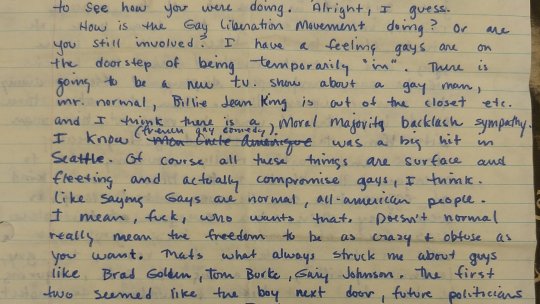
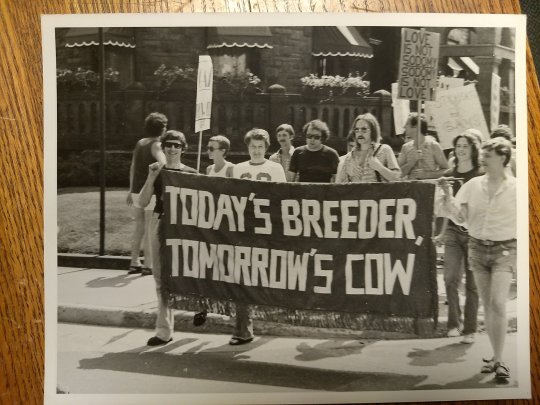
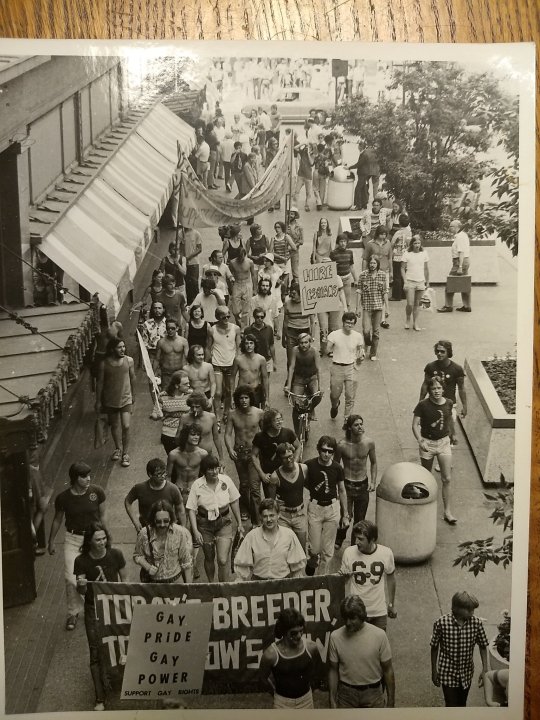
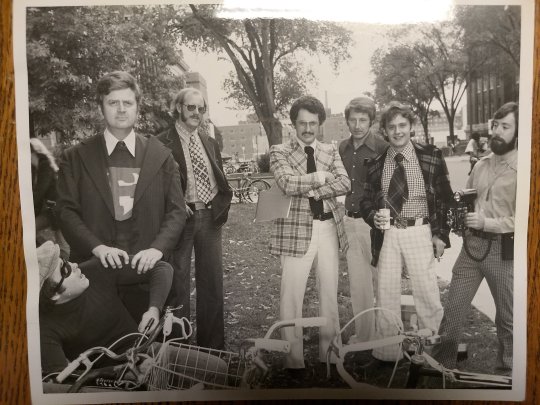
Paper and photographs from Thom Higgins, Minneapolis gay activist, most famous for throwing a pie in Anita Bryant’s face on television. His papers and photograph collection are at the Minnesota Historical society.
Excerpt from the letter, sent to Thom in 1981: "I have a feeling gays are on the doorstep of being temporarily 'in.'... Like saying, Gays are normal, all American people. I mean, fuck, who wants that."
2nd and 3rd image are from the first pride march in Minneapolis held in 1974; Thom is in front in the jean shorts, along with Jack Baker (in the 69 shirt) and Michael McConnell; Jean Tretter is also visible.
4th image shows Thom Higgins second from the right (wearing so many different patterns at once), and Jack Baker to his right, working on an ad for Gary Flokne (sp?), undated.
Finding aid for the Thom HIggins photograph collection: http://www2.mnhs.org/library/findaids/sv000295.xml
Finding aid for the Thom Higgins papers: http://www2.mnhs.org/library/findaids/00715.pdf
11 notes
·
View notes
Photo
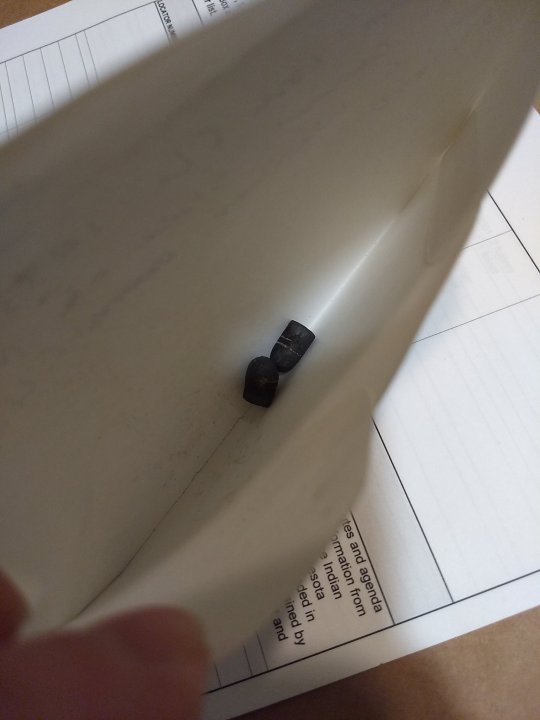
"What do we do with bullets we find in criminal case files?"
"Umm...put them in the accession file?"
1 note
·
View note
Photo

Government records archivists: trying to reconcile working for the Man with working to provide access to records that document what the Man has done.
1 note
·
View note
Photo
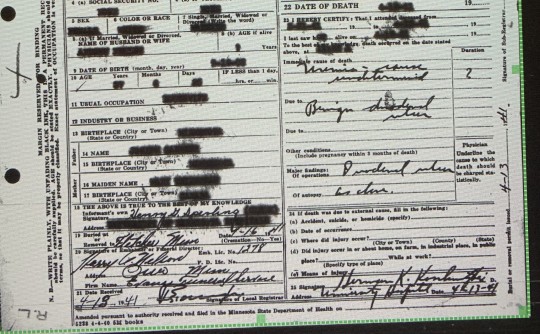

The difference between a black and white microfilm copy and a color scan. The text is pretty much unreadable in the microfilm version. Thankfully we saved the original death certs after microfilming. I don't think everything warrants full color digitization, but I am glad that it is an option these days for those cases when b&w doesn't cut it. Also I'm glad no one destroyed the originals of these particular records.
1 note
·
View note
Photo


Originally posted on Twitter on 6/28/2019:
One of my favorite parts of this (MNHS library lobby Stonewall 50) display is the empty case. It represents the erasure of queer history perpetuated by historians, curators, archivists, etc., that has happened throughout history. Text by B. Erin Cole. Also, so much of our history has been actively destroyed, either by oppressors, or by us, to avoid recrimination. Sometimes we purposely did not document our activities so we couldn't get found out. "Our stories were too controversial or, worse, too irrelevant to the stories museums like to tell through their exhibits and collections." It takes trust to give your unique, important items to a museum, and museums often don't earn that trust from communities that they don't engage with. I hope we can come to earn some trust, from many different communities. The empty case could go in many exhibits. So the answer for me and my colleagues to the question, "how to we display something we don't have?" in this case was to just address it head-on. And, museums aren't the only places that these things, the objects that do exist, need to be. Community collections, keeping traditions alive, are very important.
https://twitter.com/__anjanette/status/1144759616389222405
0 notes
Photo

when you open a new donation and -
1 note
·
View note
Photo



A recent reprocessing request, submitted by a patron in the library. I don’t know how they were able to use the collection as it original was, since it was basically completely unfoldered paper in a box. At one time there were rubber bands holding some of the like paper together but they’d long since disintegrated.
These are tariff records from the now-defunct state Railroad and Warehouse Commission, so they are one of those collections that has been around for awhile and didn’t get the processing it needed at the time of acquisition, for whatever reason. I was able to somewhat quickly sort the paper by railway line, as it was originally arranged, and put it into folders; it looks so much nicer, and I will also be able to update the date range in the finding aid, since I now have more correct dates.
Finding aid for the Railroad and Warehouse Commission Railroad Tariff Records: http://www2.mnhs.org/library/findaids/gr00116.xml
0 notes
Photo





Part 2: Photos
A photo tour documenting my last post - the Cutter archival collections are located all the way in the back left corner of one of the library stacks; Cutter number signage; folders from the last box that has minus/negative Cutter numbers; the dead shelflist cards; and the card that was the key to solving everything.
More explanation on our minus/negative Cutter system - apparently, at the time this was done, archives staff didn’t want to shelve small collections (less than one Hollinger) with the regular ones that took up one or more boxes, so they assigned them a minus to indicate they were a smaller size, and shelved them all together. Oversize Cutter collections had a plus in front of their Cutter number, and were also shelved elsewhere.
3 notes
·
View notes
Text
Documentation is Important, or, The case of the negative Cutter number
I had a juicy cataloging mystery while working on the reference desk on Tuesday, something I do two hours a week; our library is free and open to the public, and it helps me in my archivist position to work with patrons to see how they use our tools and collections. I love a good mystery, and will usually drop everything if I can to figure it out, because the satisfaction of finding something that is difficult to find is so high, and the hunt is fun (especially when you have a colleague to help you, as I do). Luckily, there weren’t very many patrons during my shift, so I was able to jump pretty deep into problem solving at that moment. (A general caveat: I’m not a cataloger, and I alternately use call number and locator number when describing archival collections’ box number/physical location-type information. I try to be consistent, but…?)
General background on us: We were established in 1849 and have been collecting since then (all types of past library, archives, and museum practice are well represented in our collections and documentation, lol). Our library and archives collection contains many different types of materials, including books and other printed materials, photographs, audio/visual material, archival collections, maps, posters, newspapers, and microfilm, which are all in our online catalog and used in our reading room. Our institution also has a 3D objects collection which is separate, and has its own online catalog. Each of these types generally has its own classification or organization system. At one time, our institution had several different reading rooms in different buildings, like one just for newspapers, one just for photographs, etc. In 1992, our current building opened, and it was the first time everything was housed together. There are always new classification/organization systems that I am discovering! Some of them are our own special creation and found nowhere else. Institutional knowledge is especially important at a place like this, because even though we have a lot of documentation, sometimes there are important details that aren’t documented, or they’re not documented consistently.
So, while I was on the reference desk, someone had a couple of request slips with call numbers already written down for Civil War-related archival collections they wanted to look at. They were what we call negative Cutter numbers (as in the Cutter Expansive Classification system, pre-Library of Congress), which is a very old way that staff used to catalog archival collections (e.g. A/+H725, or A/-H725, the plus or minus indicating different collections. Very confusing. I don’t know if the +/- thing is just something we did locally, or was used more broadly). A collection with this type of number tells me that it was acquired a very long time ago (100 years or more), and may not have been looked at in awhile.
The patron showed me where they had found one of them, the George T. Campbell papers, which was listed as a source for an article on one of our institution’s many websites (not the catalog) and which listed the collection name and call number (A/-.C174). Since it was listed on one of our sites, I didn’t check that the call number was correct. We submitted the slips to be retrieved, and the patron also wondered about an item also by Campbell that was in our 3D collection. I pulled up the record in our 3D catalog, and it was a manuscript that was being treated like a 3D object. Now, this happens sometimes (there is some overlap among our holding areas, depending on artifactual value versus content value, etc.), but it did seem strange to me that a typewritten reminiscence was in the 3D collection.
The reference assistants were unable to find the negative Cutter collections on the shelf in the stacks. This is when I had to start investigating. Starting with Campbell, first I had to verify that the call number was correct. I searched our library catalog for the collection name as written on the website the patron showed me. This did not yield anything. I also searched by call number and browsed the subjects for Campbell, but neither panned out. I then went to our paper copies of finding aids, which are organized by call number, to see if there was an inventory there, but there was not. I searched our 3D catalog again using the same collection name, and the manuscript-3D object the patron had initially found popped up as it had before. How curious. I looked again at the website where the patron had first found the collection information, and saw that it was originally published in 2013, and last updated in 2015. I knew that it was possible that the Campbell papers had been recatalogued since then and had a new call number, but what was it? It was very unlikely that the papers had been deaccessioned, given the subject matter (Civil War), so I knew they had to be around somewhere. For a minute, I had a wacko theory that the papers had been transferred from archival collections to the 3D collection in the last 5 years, but had no idea why that would be.
At this point, there was nothing else I could do while stationed at the reference desk, so I brought out the big guns. I asked a cataloger and the curator of the collection for their help, to see if they knew anything. It wasn’t an emergency, but they came right away anyway; like me, they like to solve mysteries, maybe more than any other job duty, and they are very good at it. Mystery solving comes up quite frequently here, with all of the potential for 150+ years’ worth of outdated call numbers, different physical locations over the (many) decades, etc.
While I was in the reading room, they were downstairs, looking at old accession registers, the accession file, and a set of what we call dead shelf-list cards, which list old locations for archival collections that have been assigned a new location/call number. The dead shelf-list cards were the key, because that was the only place that linked the old negative Cutter number to a new call number. (Say it with me: documentation is important.) The cataloger had recatalogued this particular collection at some point in the last few years, pulled the original shelf list card and put it with the dead ones, and annotated it with the new locations. Then she made a new shelf list card with the current information, and put it with the active/live shelf list cards, which we still maintain.
It turns out that one of the updated locator numbers was incorrect on the dead shelf list card. More importantly, however, it showed that the collection name, Campbell, was different than how it appeared in our 3D catalog and on the website that had the original citation the patron found. As soon as the cataloger searched our library catalog using the other spelling, Cambell without a P, it popped up right away. I felt so silly, as it never occurred to me to try a different spelling⸺but that’s because the other spelling was used on websites that I trusted.
Once I had the right spelling, I was able to find the George T. Cambell papers in the library catalog and write down the new call number, which staff then found in the stacks.
There are several positive outcomes for all of this time spent. First, I asked for the name misspellings and the outdated call number on the other websites to be corrected. Second, the dead shelf list card will have the correct new call numbers; and I showed the patron that we really wanted them to get to access what they came to the library to see. Access and accuracy are what we’re all about, and it’s always good when we can improve. Third, the curator will compare the item catalogued as a 3D object with what’s in the archival collection to see if they are different and should be (re)united (the curator hadn’t known there was a manuscript-type object in 3D and was extremely interested in it).
Mysteries like these pop up regularly for us, where we try to track down where the dang box is (we have over 90,000), when old finding aids or index cards or catalog records differ, where one series of documentation was updated but others were not, and we turn to several different sources to track what happened. Usually we can figure it out. I’m grateful we have so much documentation, but sometimes that also makes it difficult when the all the different types of documentation don’t agree.
My main takeaways from this experience are:
1. Always check call numbers in the library catalog, even if the patron seems experienced, even if other sites have different information. Where did this citation come from? Is it recent and up to date? Are you sure you spelled the name right? Are you sure it’s spelled right in sources you used? Why are you sure? Humans are creative with names, and anything is possible as far as names go. (There is another Minnesotan who served in the Civil War with a similar uncommon name spelling that has tripped me up before. It is spelled differently in different sources⸺Mathew/Matthew Marvin. Sometimes people spelled their own names differently over time, or were just plain inconsistent, making finding all of the resources on or about them at one time difficult.)
2. Documentation is important!
3. If one website is updated, all websites should be updated, if at all possible. Otherwise staff and the public alike will get confused.
Coda: There was a second negative Cutter collection that staff couldn’t find on the shelf, but that one was easier to find. The patron had written down the collection name, H. Adams, on the request slip, but I found out it was incomplete when I searched. I searched the catalog with what they had written down and added “Civil War.” That led me to the catalog record, with the complete name, H. Adams Hair, and an updated call number. Happy patron, happy staff member.
Catalog record for George T. Cambell papers: https://mnpals-mhs.primo.exlibrisgroup.com/discovery/fulldisplay?docid=alma990017350490104294&context=L&vid=01MNPALS_MHS:MHS&search_scope=MyInstitution&tab=LibraryCatalog&lang=en
1 note
·
View note